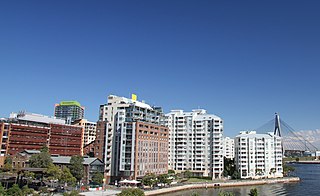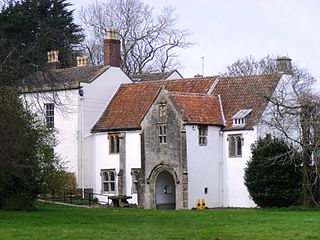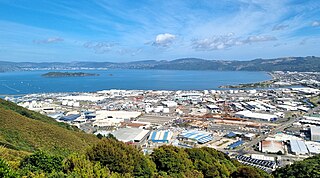
Richard Barton was the first European resident of Trentham, Upper Hutt, in New Zealand. He was born in Newport, Isle of Wight, England.

Petone is a large suburb of Lower Hutt, Wellington. It stands at the southern end of the Hutt Valley, on the northern shore of Wellington Harbour. Europeans first settled in Petone in January 1840, making it the oldest European settlement in the Wellington Region. It became a borough in 1888, and merged with Lower Hutt in 1989. In November 2023, Hutt City Council decided to consult the New Zealand Geographic Board about changing the suburb's name to "Pito-one" - the area's original Māori name.

Geraldine is a town in the Canterbury region in the South Island of New Zealand. It is about 140 km south of Christchurch, and inland from Timaru, which is 38 km to the south. Geraldine is located on State Highway 79 between the Orari and Hae Hae Te Moana Rivers and 45 kilometres to the east of Fairlie.

Glebe is an inner-western suburb of Sydney in New South Wales. Glebe is located 3 kilometres (1.9 mi) southwest of the Sydney central business district in the Inner West region.

Pyrmont is an inner-city suburb of Sydney, in the state of New South Wales, Australia 2 kilometres south-west of the Sydney central business district in the local government area of the City of Sydney. It is also part of the Darling Harbour region.

Rozelle is a suburb in the inner west of Sydney, in the state of New South Wales, Australia. It is located 4 kilometres west of the Sydney central business district, in the local government area of the Inner West Council.

Glebe Park is a public park on the eastern side of Civic, Canberra, Australia. The park is bounded by Coranderrk, Ballumbir, Akuna, and Bunda Streets, and to the south, the National Convention Centre.

Newnham is a village and civil parish in the Syndale valley in Kent, England, in the administrative borough of Swale near the medieval market town of Faversham.

Wellington railway station, Wellington Central station, or simply Wellington station, is the main railway station serving Wellington, New Zealand, and is the southern terminus of the North Island Main Trunk, Wairarapa Line and Johnsonville Line.

Frederick de Jersey Clere was an architect in Wellington, New Zealand.

All Souls is an Anglican church in the Diocese of Sydney. The church is located in the corner of Norton and Marion Streets, Leichhardt, New South Wales, Australia.

The Upper Hutt Blockhouse also known as the Wallaceville Blockhouse is a 19th-century American-style military blockhouse situated in Upper Hutt, New Zealand. One of very few such blockhouses built in New Zealand, it is preserved as a Category I historic place. It was built in late 1860 as part of a larger Stockade and was one of two Blockhouses and Stockades built in the Hutt Valley that year. It was occupied by the Hutt Battalion of the Wellington Militia from December 1860 to May 1861 without coming under hostile attack.

St Mary the Virgin is a 13th-century Anglican parish church in Northolt, London Borough of Ealing. It is on a slope shared with Belvue Park, the site of a 15th-century manor house — both overlooked the old village of Northolt. It is one of London's smallest churches, its nave measuring 15 yards (14 m) by 8 yards (7.3 m). The church was built around 1290 and was expanded over the centuries, with the chancel being added in 1521, the spired bell tower in the 16th century, and a gallery at the west end of the church in 1703. Twin buttresses were erected against the west wall around 1718 to alleviate concerns that the church could slip down the hill. The internal beams are original and the bells date from the 17th century. The church was constructed from a variety of materials; the nave incorporates clunch, flint and ironstone, and the mouldings of the doors and windows are made from Reigate Stone.

The Vicarage in Congresbury, Somerset, England, includes an early 19th-century vicarage and former Priests House from around 1446. It has been designated as a Grade I listed building.

Seaview is an industrial suburb of the city of Lower Hutt, in Wellington, New Zealand. Situated on the eastern coast of the Hutt Valley, the suburb lies between Te Awa Kairangi / the Hutt River and Petone, and the bays of Eastbourne to the south. Seaview is a centre for bulk liquid fuel storage for the lower half of the North Island, and a site for heavy industry. It is also a base for support services for trucks and transportation businesses and the location of the wastewater treatment plant for drainage from the Hutt Valley. Seaview is home to the Port Road Drags, the longest-running street drag races in Australasia.

Bellevue is a heritage-listed former residence and timber yard and now cafe located at 55–57 Leichhardt Street in the inner city Sydney suburb of Glebe Point in the City of Sydney local government area of New South Wales, Australia. It was designed by Ambrose Thornley Junior and built in 1896 for William Jarrett who lived in the adjoining house. It is also known as site of former Venetia (demolished) and 55 Leichhardt Street. The property is owned by the City of Sydney Council. It was added to the New South Wales State Heritage Register on 2 April 1999.

St John's Anglican Church is a heritage-listed Anglican church located at 563 Fergusson Drive, Trentham, Upper Hutt, New Zealand. The church is one of the oldest surviving Anglican churches in the Wellington region. Heritage New Zealand classified it a Category 2 historic building on 6 June 1983.

All Saints Church, Benhilton, is an English parish church within the Anglican Diocese of Southwark in the Church of England. The church is located in Sutton, Greater London, in the Sutton parish of Benhilton and was built between 1863 and 1867. It is a Grade II* listed church and has been described by Historic England as "a fine example of mid-Victorian church-building by an important architect of the Gothic Revival".

All Saints Church in Palmerston North, New Zealand, is an Anglican heritage-registered church designed by eminent architect Frederick de Jersey Clere. The church has been closed since 2013 over concerns about earthquake resistance but there are plans to strengthen the structure.

The Railways Department's Housing Scheme refers to a housing programme undertaken by the New Zealand Railways Department during the 1920s. The scheme was intended to provide railway workers and their families with affordable and accessible accommodation during a time when it was otherwise difficult to find suitable housing.





















